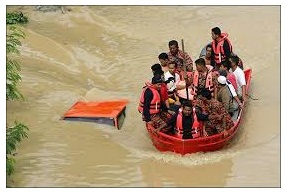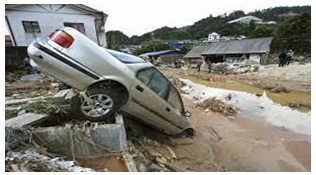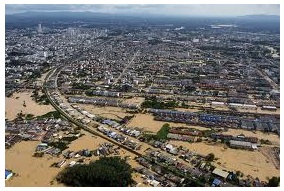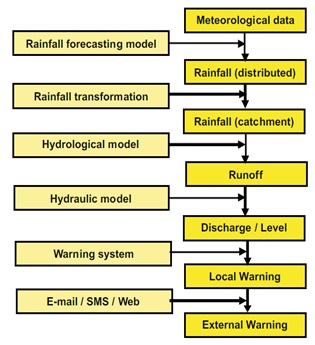 Floods are hydrological events caused by abnormally high amounts of water input and insufficient discharge capacity. Early flood warning systems are instigated to warn emergency services, local and central government as well as those communities at risk to take effective action before the occurrence of a likely flood. Effective early flood warning is essential if local authorities and emergency services can undertake the necessary measures to mitigate the effects of a potential flood and to warn the population of a possible threat. Early flood warning systems serve to save lives, to minimize flood damage to properties and reduce economic and social losses. The detection of the likelihood for flooding is achieved by meteorological and hydrological observations. Model based early flood warning systems are sometimes not feasible to validate hydrological prediction models due to practicality and financial constraints. Therefore, this research is initiated to provide a one-stop-decision support system (DSS) platform of data dissemination and advanced analysis for flood early warning system via web and mobile-based medium.
Floods are hydrological events caused by abnormally high amounts of water input and insufficient discharge capacity. Early flood warning systems are instigated to warn emergency services, local and central government as well as those communities at risk to take effective action before the occurrence of a likely flood. Effective early flood warning is essential if local authorities and emergency services can undertake the necessary measures to mitigate the effects of a potential flood and to warn the population of a possible threat. Early flood warning systems serve to save lives, to minimize flood damage to properties and reduce economic and social losses. The detection of the likelihood for flooding is achieved by meteorological and hydrological observations. Model based early flood warning systems are sometimes not feasible to validate hydrological prediction models due to practicality and financial constraints. Therefore, this research is initiated to provide a one-stop-decision support system (DSS) platform of data dissemination and advanced analysis for flood early warning system via web and mobile-based medium.
1. EWS serve to save lives
Flood warning is a crucial part of the flood management system, but it can only be useful if integrated in pre and post flood
activities. Early flood warning systems are essential for the protection of the population against flood hazards as it allows people to get prepared. However, early flood warning systems will not prevent flooding. Increased public awareness of floods and a high level of community preparedness can be achieved and maintained by educational programs. The public must be involved through government organizations and local government initiatives to assess flood risk and make the necessary actions to mitigate as best as possible.
 2. Minimize flood damage to properties
2. Minimize flood damage to properties
Floods, big or small, can happen to anyone at any time of the year. Those who live by bodies of water may have experienced a flood or those who have had a washing machine with a mind of their own may have experienced a flood on a different scale. No matter what type of flood one may experience, there is always a level of frustration involved when trying to recover from it.
3. Reduce economic and social losses
Floods have the greatest damage potential of all natural disasters worldwide and affect the greatest number of people. On a global basis, there is evidence that the number of people affected and economic damages resulting from flooding are on the rise at an alarming rate. Society must move from the current paradigm of post-disaster response. Plans and efforts must be undertaken to break the current event-disaster cycle. More than ever, there is the need for decision makers to adopt holistic approaches for flood disaster management. Extreme flooding events are not relegated to the least developed nations, but can also devastate and ravage the most economically advanced and industrialized nations.
How EWS works?
 A rainfall forecasting model is used to produce spatially distributed rainfall forecasts from meteorological data. The rainfall data are subsequently transformed into spatially averaged catchment rainfall for each sub catchment in the study area. The sub catchment rainfall serves as input for a hydrological model, which predicts sub catchment runoff. The runoff is used as input for a hydraulic model. The hydraulic model predicts the discharge in the main study area and the water levels in the storage/river reservoirs. The warning system interprets all forecasts and issues a warning, whenever necessary.
A rainfall forecasting model is used to produce spatially distributed rainfall forecasts from meteorological data. The rainfall data are subsequently transformed into spatially averaged catchment rainfall for each sub catchment in the study area. The sub catchment rainfall serves as input for a hydrological model, which predicts sub catchment runoff. The runoff is used as input for a hydraulic model. The hydraulic model predicts the discharge in the main study area and the water levels in the storage/river reservoirs. The warning system interprets all forecasts and issues a warning, whenever necessary.
References:
- Price, R.K., 2006: Handout on Hydroinformatics for Flood Management – Unit 1.3 of I-Learning Module on Flood Management for Modelling, Unesco – IHE, Institute for Water Education.
- Plate, E.J. & Insisiengmay, T., 2005. Early warning system for the lower Mekong River. Water International 30 (1): 99-107.